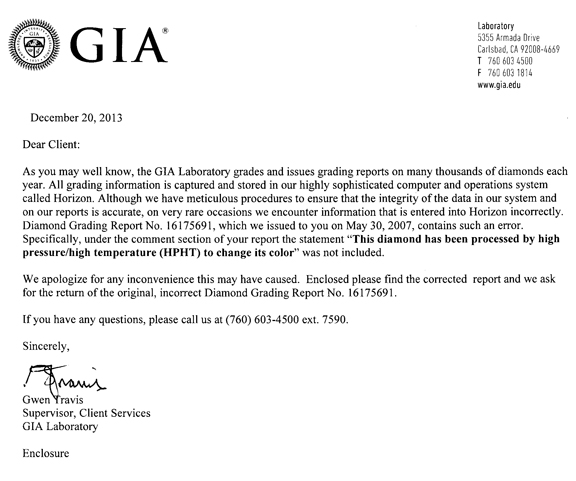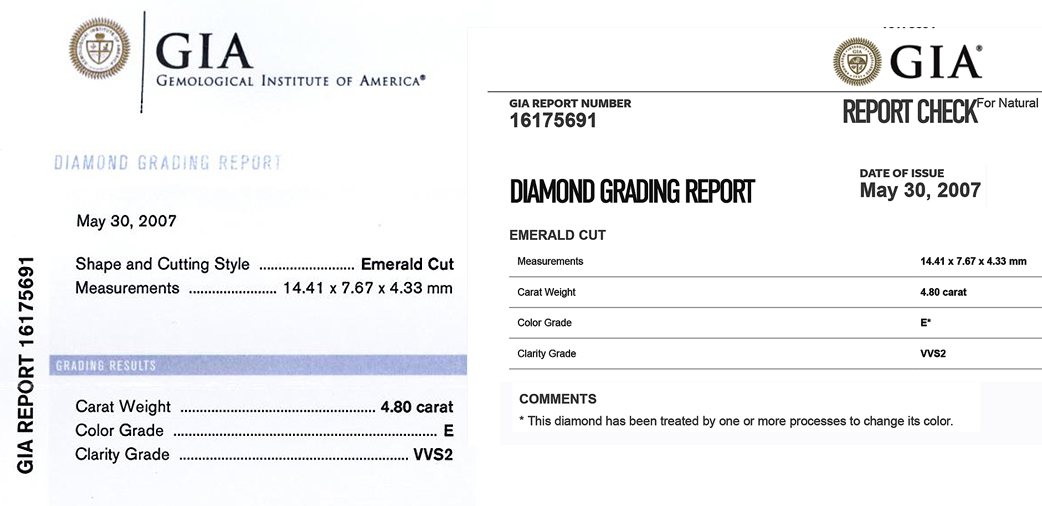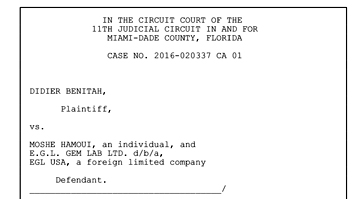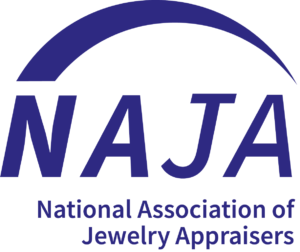ISG: What happens in court when the lab made the mistake?
“The GIA mistake is the sole cause of the Parties mutual mistake which destroyed any potential…”
JAMS ARBITRATOR: Heritage v. Hilo
Do you sell diamonds using a GIA, EGL, IGI, or other diamond grading report? Do you rely on that report to represent the diamond grade to your customer? Have you ever read the small print on the back of that grading report regarding lab liability for errors? Have you ever thought about what would happen if that report, for some reason or cause, contained errors? Who would be responsible for the errors? And, more importantly, who would have to pay for the error.
If you answered “Yes” to the first two questions, and “No” to the third you should be seriously thinking about the answer to the last three questions. The answers may surprise you as they did with others who did not bother to ask those questions in time and found the answers the hard way.
Here is another question: Could you put a disclaimer on your receipt that says:
“My Jewelry Store is not responsible for any loss you experience resulting from any error we made regarding your sale. We are not responsible even if your loss is caused by our negligence, or the negligence of any of our employees.”
Could you put that on your sales receipts and expect customers to feel confident in their purchase from your store?
Well, here is the actual fine print on the back of one major lab grading report, and if one reads the fine print on virtually all of the major labs the verbiage is virtually identical”
“GIA and its employees and agents shall not be liable for any loss, damage or expense resulting from any error in or omission from this report or from the issuance of or use of this report or any inscription, even if the loss, damage or expense was caused by or resulted from the negligence or other fault of GIA or any of its employees…”
So, in this example, if any GIA employee is negligent or at fault for an error in a grading report you use to sell to your customer, they take no responsibility for the loss or costs of dealing with that error.
Now, how does this play out in real life? Over the years I have been involved in many litigation cases that dealt with just this issue. I am going to pick one to present to you today since they all play out pretty much the same as this case:
Heritage Auctioneers & Galleries vs. Hilou, Susanne, et al. JAMS Ref. No. 1310020839
This case involved a diamond dealer, Susanne Hilou, who sold a 4.80 carat emerald cut diamond of natural E color and VVS2 clarity with a GIA Diamond Grading Report #16175691, through the above-mentioned auction house. After the sale, the new owner sent it back to the GIA for verification.
The diamond came back as HPHT treated. Color enhanced. The buyer demanded their money back due to deception. The seller refused, claiming the diamond was graded by the GIA and not her responsibility. The parties contacted the GIA on the matter who basically responded: “Oops, our mistake, but not our fault. You all work it out for yourselves”.
Here is the letter from the GIA admitting to the error, but again, taking no responsibility for the buyer’s loss from the GIA report error.

To avoid the cost of a full-on litigation case, the parties agreed to Alternative Dispute Resolution through binding arbitration of JAMS (Judicial Arbitration and Mediation Services). I was an expert witness and consultant to one side in the case.
The GIA refused to show up and testify regarding the error in their report. They reissued the original GIA Grading Report No. 16175691 but this time with HPHT treatment. Below is a look at the original report, and the current report from the GIA website showing the same number and diamond, but one with HPHT and one without HPHT. And that is as far as they would go to deal with the error.

Here is how the Final Award was decided in this case with sections quoted directly from the JAMS arbitration final report:
This Arbitrator finds and concludes as follows: (we will skip to the main issues)
- The GIA Grading Report No. 16175691 was wrong and mistakenly omitted the disclosure that The Diamond had been HPHT treated and GIA failed to inscribe The Diamond as such.
- The original GIA Grading Report No. 16175691, issued May 30, 2007 accompanied The Diamond at catalog and auction and was innocently and justifiably relied on by all Parties.
- HPHT treatment of The Diamond is a material fact unknown to these Parties.
- GIA’s mistake is the sole cause of the Parties mutual mistake which destroyed any potential for the Parties “minds to meet” and bind the Parties to contract in the auction transaction.
- Each Party should suffer their own fees and costs as incurred as no innocent Party should be required to pay another’s fees and costs…
In other words, the GIA error was the cause of the problem. Both the seller and buyer were innocent parties to the GIA error, but the seller and buyer had to pay the costs of dealing with the GIA error. The GIA refused to the end to participate.
This scenario has been repeated over and over. My own experience with the now defunct AGTA Gem Trade Lab whose lab reports were thrown out of California Appeals Court litigation under the “Hearsay Rule” in Direct Shopping Network v. Robert James, Colored Stone Magazine, 206 Cal.App.4th 1551 (2012) 143 Cal.Rptr.3d 1.
 Or the EGL Diamond Reports that totally missed an HPHT treated diamond creating litigation in Didier Benitah v. EGL Lab Ltd., et al. 11th Circuit Court of the 11th Judicial Circuit in and for Miami-Dade County, Florida. Case #2016-020337 CA 01. The EGL admitted to the error but would take no financial responsibility for the dispute it created between the seller and buyer.
Or the EGL Diamond Reports that totally missed an HPHT treated diamond creating litigation in Didier Benitah v. EGL Lab Ltd., et al. 11th Circuit Court of the 11th Judicial Circuit in and for Miami-Dade County, Florida. Case #2016-020337 CA 01. The EGL admitted to the error but would take no financial responsibility for the dispute it created between the seller and buyer.
So, what should jewelers and consumers do to avoid what are actually just sales tools, and not true lab certification grading reports? The Answer is simple:
The Local, Home-Town Jeweler and Appraiser
Unlike the far-off major labs who refuse to take responsibility for their errors, the home town jeweler and jewelry appraiser is, in fact, legally liable for their errors and omissions, and are actually far more trustworthy.
 As a Property and Casualty Insurance Adjuster, I have worked on high value jewelry claims and litigation for over 23 years in the United States and Europe. Throughout all of my experiences, the most trustworthy and accurate grading I have seen on diamonds, colored gemstones, or anything else regarding appraisals has come from certified members of the National Association of Jewelry Appraisers. While there are other appraisal organizations out there, the NAJA is the one that has the most advanced education in appraisal, and who maintains high standards from year to year through ongoing education requirements. (click the icon)
As a Property and Casualty Insurance Adjuster, I have worked on high value jewelry claims and litigation for over 23 years in the United States and Europe. Throughout all of my experiences, the most trustworthy and accurate grading I have seen on diamonds, colored gemstones, or anything else regarding appraisals has come from certified members of the National Association of Jewelry Appraisers. While there are other appraisal organizations out there, the NAJA is the one that has the most advanced education in appraisal, and who maintains high standards from year to year through ongoing education requirements. (click the icon)
Conclusion
Jewelers can continue to pour literally millions of dollars into the pockets of the major grading labs, but the case history above should tell you what to expect when errors and omissions are found in those reports. How are you and your customer going to be treated when a major lab error forces a conflict between you?
Legally, ethically, accurately, all aspects of this issue point to the one conclusion that is unavoidable: the local, properly trained appraiser stands far above any of the major labs.
The major labs are literally raking in millions of dollars and taking it straight to the bank because they know they don’t have to care about you or how it affects your customer if there is an error in their product.
Can any of us say the same about our own businesses.
Robert James, FGA, GG
President, International School of Gemology
Global Claims Associates
Texas Department of Insurance Property and Casualty Adjuster License #130043
Member: National Association of Independent Insurance Adjusters
Member: Insurance Appraisal and Umpire Association
Associate Member: American Bar Association
If you have a claim, case, or dispute that requires a highly experienced expert witness, investigator, or consultant, give us a call at the Global Claims Associates. We offer a proven track record of winning cases and resolving disputes on high value jewelry, gemstones, and other personal property.

